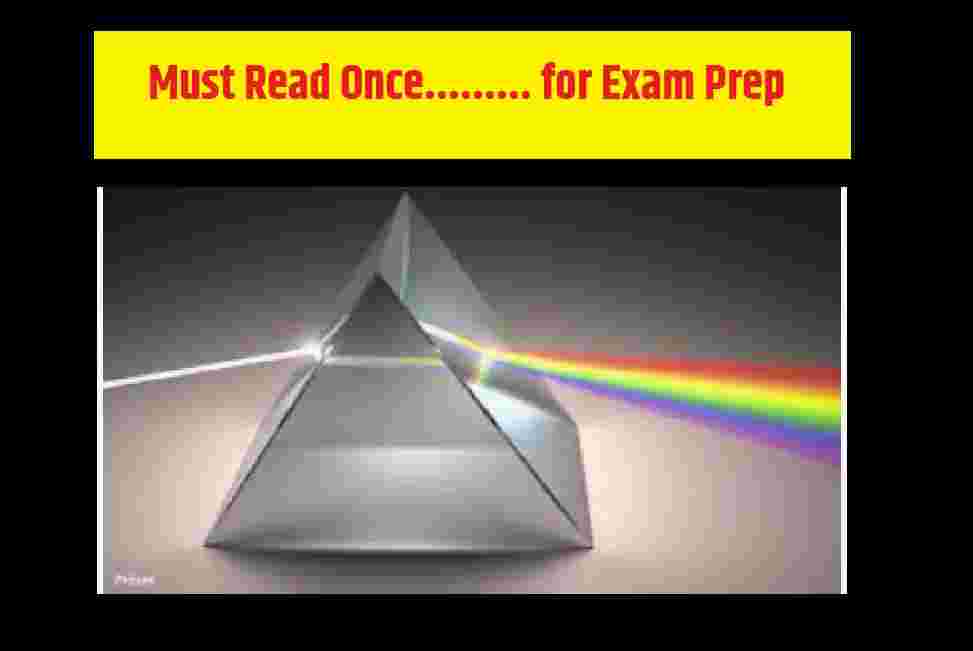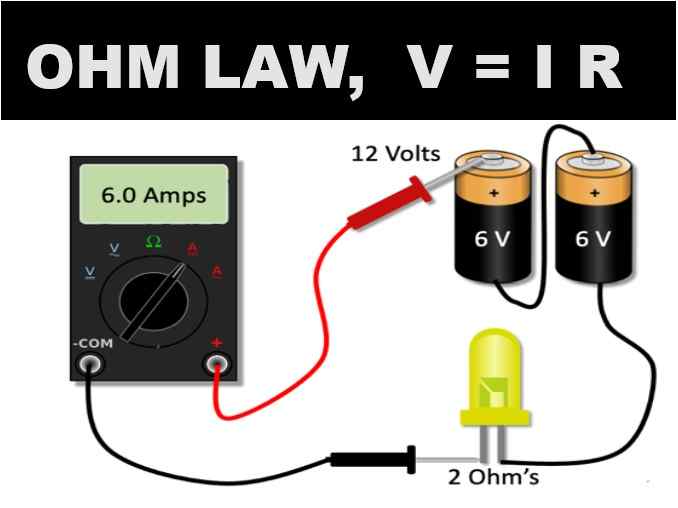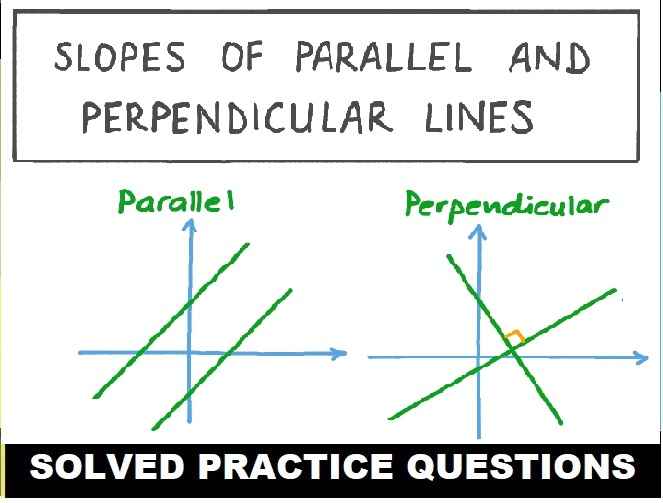MCQs Refraction and Dispersion of Light Prism for ISC Class 12 . These MCQs / Objective Type Questions is based on latest reduced syllabus according 2021-22 session on bifurcated pattern. Main motto of MCQ Type Question is cracking the next upcoming Sem-2 exam of council. Visit official website CISCE for detail information about ISC Class-12 Physics.
ISC Class 12 MCQs Refraction and Dispersion of Light Prism

| Board | ISC |
| Class | 12th (XII) |
| Subject | Physics |
| Chapter | Refraction of Dispersion of Light a Prism |
| Syllabus | on bifurcated syllabus (after reduction) |
| Session | 2021-22 |
| Bifurcated | Sem-2 |
| Topic | MCQs / Objective Type Question |
Important MCQs Refraction of Dispersion of Light Prism for ISC Class 12
Question 1: When white light enters a prism, it gets splitted into its constituent colours. This is due to:
(a) diffraction of light
(b) interference of light
(c) high density of prism material
(d) because speed of light is different for different wavelengths
Answer: (d) because speed of light is different for different wavelengths
Question 2: Which ray is least deviated by a prism?
(a) Violet ray
(b) Green ray
(c) Red ray
(d) Yellow ray
Answer: (c) Red ray
Question 3: If a glass prism is dipped in water, its dispersive power
(a) decreases
(b) increases
(c) does not change
(d) may increase or decrease depending on whether the angle of the prism is less than or greater than 60º
Answer: (a) decreases
Question 4: When white light passes through a prism, then it splits into seven colours which are known as the dispersion of light. So after coming out of a prism, which of the colour of light scatters the least?
(a) Red
(b) Violet
(c) Blue
(d) Green
Answer: (a) Red
Question 5: The refractive index of a particular material is 1.67 for blue light, 1.65 for yellow light and 1.63 for red light. The dispersive power of the material is
(a) 0.0615
(b) 0.024
(c) 0.031
(d) 1.60
Answer: (b) 0.024
Question 6: A prism (μ=1.5) has a refracting angle of 300. The deviation of a monochromatic ray incident normally on its one surface will be
(a) 180 36’
(b) 200 30’
(c) 180
(d) 190 30’
Answer: (a) 180 36’
Question 7: Yellow light is refracted through a prism producing minimum deviation. If i1 and i2 denote the angle of incidence and emergence for this prism, then
(a) i1 = i2
(b) i1 > i2
(c) i1 + i2 = 90
(d) None of these
Answer: (a) i1 = i2
Question 8: The angle of the prism is equal to the angle of minimum deviation for a prism of refractive index 1.5. What is the value of the angle of the prism?
(a) 410
(b) 820
(c) 620
(d) 310
Answer: (b) 820
Question 9: The refractive angle of a prism for a monochromatic light is 600 and refractive index is √2. For minimum deviation, the angle of incidence will be
(a) 600
(b) 450
(c) 300
(d) 750
Answer: (b) 450
Question 10: When white light is passed through a hollow prism then there is
(a) no dispersion and no deviation
(b) Only dispersion
(c) Only deviation
(d) Both dispersion and deviation
Answer: (a) no dispersion and no deviation
Question 11: The angle of prism is 60° and angle of deviation is 30°. In the position of minimum deviation, the values of angle of incidence and angle of emergence are:
(a) i = 45º ; e = 45º
(b) i = 45º ; e = 50º
(c) i = 30º ; e = 45º
(d) None of these
Answer: (a) i = 45º ; e = 45º
Question 12: The angular dispersion produced by a prism
(a) increases if the average refractive index increases
(b) increases if the average refractive index decreases
(c) remains constant whether the average refractive index increases or decreases
(d) has no relation with average refractive index
Answer: (a) increases if the average refractive index increases
Question 13: A thin prism P1 with angle 4° and made from glass of refractive index 1.54 is combined with another prism P2 made of glass of refractive index 1.72 to produce dispersion without deviation. The angle of prism P2 is
(a) 3°
(b) 2.6°
(c) 4°
(d) 5.33°
Answer: (a) 3°
Question 14: The refracting angle of a prism is ‘A’, and refractive index of the material of the prism is cot(A/2). The angle of minimum deviation is :
(a) 180° – 2A
(b) 90° – A
(c) 180° – 3A
(d) 180° + 2A
Answer: (a) 180° – 2A
Question 15: By properly combining two prisms made of different materials, it is not possible to have
(a) neither dispersion nor average deviation
(b) both dispersion and average deviation
(c) deviation without dispersion
(d) dispersion without average deviation
Answer: (a) neither dispersion nor average deviation
Question 16: The critical angle between an equilateral prism and air is 45. If the incident ray is perpendicular to the refracting surface, then
(a) It is reflected totally from the second surface and emerges perpendicular from the third surface.
(b) It gets reflected from second and third surfaces and emerges from the first surface
(c) It keeps reflecting from all the three sides of the prism and never emerges out
(d) After deviation, it gets refracted from the second surface
Answer: (a) It is reflected totally from the second surface and emerges perpendicular from the third surface.
Question 17: When the incidence angle is equal to the angle of emergence of light from the prism the refracted ray inside the prism
(a) becomes parallel to the base of prism
(b) becomes perpendicular to the left face of prism
(c) becomes perpendicular to the base of prism
(d) becomes parallel to the right face of prism
Answer: (a) becomes parallel to the base of prism
Question 18: The dispersive power will be maximum for
(a) Flint glass
(b) Crown glass
(c) Mixture of glass
(d) None of these
Answer: (a) Flint glass
Question 19: A monochromatic light is passed through a prism,….. colour shows minimum deviation
(a) Red
(b) Violet
(c) Yellow
(d) Green
Answer: (d) Green
Question 20: Light of wavelength 4000 Å is incident at small angle on a prism of apex angle 4°. The prism has nv = 1.5 and nr = 1.48. The angle of dispersion produced by the prism in this light is
(a) None of these
(b) 0.08°
(c) 0.2°
(d) 0.192°
Answer: (a)None of these
Question 21: A ray of light is incident normally on one refracting surface of an equilateral prism. If the refractive index of the material of the prism is 1.5, then
(a) the ray undergoes total internal reflection at second refracting surface
(b) the ray emerges normally from the second refracting surface
(c) the emergent ray just graces the second reflecting surface
(d) the emergent ray is deviated by 60°
Answer: (a) the ray undergoes total internal reflection at second refracting surface
Question 22: If the angle of prism is 60 ° and the angle of minimum deviation is 40 ° , the angle of refraction will be
(a) 30 °
(b) 60 °
(c) 100 °
(d) 120 °
Answer: (a) 30 °
Question 23: The dispersive power of prism depends upon
(a) The shape of the prism
(b) The material of the prism
(c) The angle of the prism
(d) Height of the prism
Answer: (b) The material of the prism
Question 24: Which one of the following alternative is FALSE for a prism placed in a position of minimum deviation
(a) i 1 = i 2
(b) r 1 = r 2
(c) i 1 = r 1
(d) All of these
Answer: (c) i 1 = r 1
Question 25: For a wavelength l the dispersion of the medium is D, then the dispersion for the wavelength 2l will be
(a) D/8
(b) D/2
(c) 2D
(d) D
Answer: (a) D/8
Question 26: The process of splitting white light into its seven constituent colours is called
(a) Refraction
(b) Dispersion
(c) Scattering
(d) Reflection
Answer: (b) Dispersion
Question 27: Splitting of light into its colours is known as?
(a) Total internal refraction
(b) Refraction
(c) Diffraction
(d) Dispersion
Answer: (d) Dispersion
Question 28: The refractive index of the material of prism is √ 2 and its refracting angle is 30 ° . One of the refracting surfaces of the prism is made a mirror inwards. A beam of monochromatic light entering the prism from the other face will retrace its path after reflection from the mirrored surface if its angle of incidence on the prism is
(a) 45 °
(b) 60 °
(c) 0 °
(d) 30 °
Answer: (a) 45 °
Question 29: Rainbow is formed due to
(a) Refraction
(b) Dispersion and total internal reflection
(c) Total internal reflection
(d) Scattering
Answer: (b) Dispersion and total internal reflection
Question 30: The angle of a prism is 30 ° . The rays incident at 60 o at one refracting face suffer a deviation of 30 ° . The angle of emergence is
(a) 0 °
(b) 30 °
(c) 60 °
(d) 90 °
Answer: (b) 30 °
Question 31: When white light passes through the achromatic combination of prism, then what is observed
(a) Dispersion
(b) Deviation
(c) Dispersion and deviation
(d) None of the above
Answer: (b) Deviation
Question 32: If the refractive angles of two prisms made of crown glass are 10 ° and 20 ° respectively, then the ratio of their colour deviation powers will be
(a) 1 : 1
(b) 2 : 1
(c) 4 : 1
(d) 1 : 2
Answer: (d) 1 : 2
Question 33: The refracting angle of a prism A is small. The correct statement for the dispersive power of a prism is that dispersive power
(a) Depends upon the material of the prism
(b) Depends upon both material and angle of prism
(c) Depends only upon refracting angle of prism
(d) Is same for all colors of white light
Answer: (a) Depends upon the material of the prism
Question 34: In an experimental arrangement of a Fresnel’ biprism, monochromatic light of wavelength λ is used to produce interference fringe pattern. On introducing a thin, transparent glass sheet of refractive index 1.50 and thickness of 7 microns in the path of one of the interfering beams, the central fringe of the pattern is shifted to the position of 6th bright fringe. Then, the wavelength λ of the monochromatic light used is nearly:
(a) 55 nm
(b) 650 nm
(c) 618 nm
(d) 583 nm
Answer: (d) 583 nm
Question 35: Name the scientist who first used a glass prism to obtain the spectrum of sunlight
(a) C. V. Raman
(b) Lord Rayleigh
(c) Issac Newton
(d) S. Chandrasekhar
Answer: (c) Issac Newton
Question 36: The refractive index of a thin prism of prism angle 5° is 1.4. Find the angle of deviation of light ray falling on this prism.
(a) 3°
(b) 2°
(c) 7°
(d) 6°
Answer: (b) 2°
Question 37: The refractive indices of Kerosene, Turpentine and water are 1.44, 1.47 and 1.33 respectively. Light will have maximum speed in:
(a) Kerosene
(b) Turpentine
(c) Water
(d) Speed remains same for all
Answer: (a) Water
Question 38: A light ray is passing through a thin prism of prism angle 8°. Find the refractive index of the prism if the angle of deviation is 2°.
(a) 1.5
(b) 2
(c) 1.25
(d) 2.25
Answer: (c) 1.25
Question 39: Dispersion of light is due to
(a) Wavelength
(b) Intensity of light
(c) Density of medium
(d) None of these
Answer: (a) Wavelength
Question 40: Which of the following is observed when white light passes through a hollow prism?
(a) Dispersion only
(b) Deviation only
(c) Both dispersion and deviation
(d) None of the above
Answer: (d) None of the above
–: End of MCQs Refraction and Dispersion of Light Prism :–
-: also visit :-
- ISC Sem-2 Question Bank Class-12
- Sem-2 ISC Specimen Paper for Class-12
- ISC Class-12 Textbook Solutions ,Syllabus, Solved Paper
- Previous Year Question Paper for ISC Class-12
Please share with your ISC friends if it is helpful
Thanks


